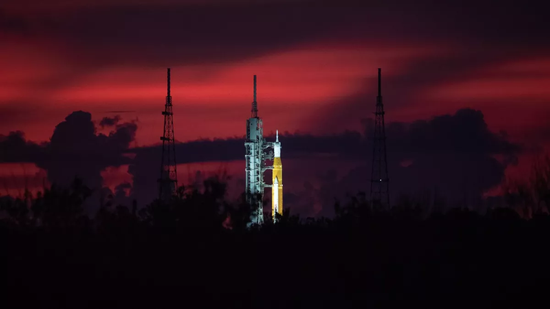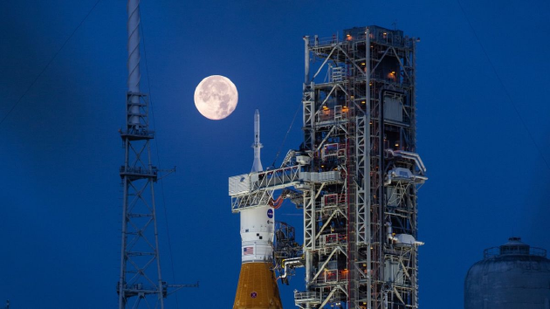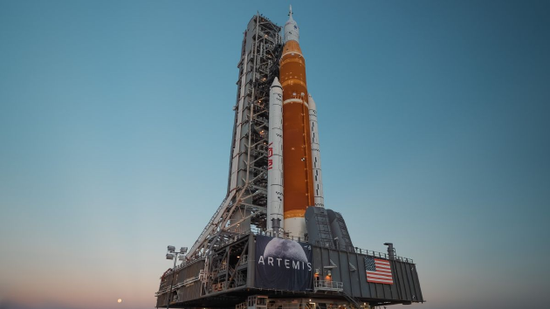your current location is:Home > TechnologyHomeTechnology
The U.S. Moon Landing Rocket Artemis 1 Mission Has Four Thrilling "Intensive Moments"!

Sina Technology News Beijing time on the morning of August 31st, according to reports, at present, NASA's "Artemis 1" was originally planned to be launched at 8:33 on August 29th Eastern Time (Beijing time on August 29th 20th) 33:00 a.m.), but the lunar rocket's scheduled launch on the 29th was canceled after the technical team was unable to fix a problem with one of the rocket's engines due to a fuel leak.
Today, NASA announced that the agency will attempt to launch the Artemis 1 lunar rocket mission again this Saturday (September 4, Beijing time).
The launch of the world's most powerful rocket may be just the beginning of human exploration of space. The mission is one of the last two test steps before NASA's official moon landing. The "Artemis 1" rocket will fly for 42 days , a round-trip journey of 2.1 million kilometers, including a round-trip flyby of 64,374 kilometers on the far side of the moon, and two close flybys of 100 kilometers above the lunar surface. During this period, the spacecraft will experience four thrilling "nervous moments".
The space mission, named Artemis 1, is a three-time Artemis mission, said Pat Troutman, strategy and architecture liaison for NASA's Moon-Mars Exploration Architecture Development Office The first for the mission, which will peak in 2025, will see astronauts set foot on the moon for the first time in 50 years and send the first-ever female and astronaut of color to the moon.
 Close-up of NASA's SLS rocket
Close-up of NASA's SLS rocketHowever, even if each leg of the 1,000 light-year space journey begins with the first step, the mission's first launch of the Space Launch System (SLS) rocket will be completely unmanned, with just three mannequins on top of the rocket's Orion capsule .
"This is the first flight of a large space system, which is a highly integrated, complex and energetic launch system, and normally we would like to test these capabilities for the first time without getting too close," Troutman said. "
"Moon Ghost Passenger"
What does NASA hope to learn from this unmanned mission to the moon? Troutman pointed out that Artemis 1 mainly tests two things: the performance of the SLS rocket and the Orion capsule, and the safety of the astronauts in the capsule.
To complete the mission, the "astronauts" will be played by three mannequins in the Orion capsule, with Commander Munigin Campos in the front row (the mannequin named after a former NASA scientist) Named after Arturo Campos, who was key to the 1970 Apollo 13 mission), who will test NASA's newest spacesuit, the Orion Crew Survival System flight suit, with Hull and Zuha behind him They are "ghost passengers," or mannequins without limbs. It is reported that Hull and Zuhar were named after the space mission partners Germany and Israel.
Campos and Zuhar will don special vests to protect them from the intense solar radiation that Earth's atmosphere normally blocks, and a third vest-wearing mannequin will serve as an experimental control. All three mannequins will be placed on chairs equipped with sensors to measure acceleration and vibration during spacecraft launch and return to Earth. After the mission, by studying lunar satellites and associated sensor data, NASA should More comprehensively plan for future phases of the Artemis program and the potential bodily stress radiation exposure that human astronauts may experience.
Four "tense moments"
Evaluating the durability and functionality of the spacecraft itself is another key objective of the Artemis 1 mission, and the best test of the SLS rocket and Orion's capabilities will pass through four key "tense moments," Trautman said. authenticating.
 The SLS rocket, the most powerful space rocket ever built, will experience four thrilling "nervous moments" during the Artemis 1 mission.
The SLS rocket, the most powerful space rocket ever built, will experience four thrilling "nervous moments" during the Artemis 1 mission.The first "nervous moment" was the SLS rocket launch, the 98-meter-tall rocket's four giant RS-25 engines ignited, and the rocket would lift off from the launch pad at the Kennedy Space Center in Florida, USA, and climb upward in the Earth's atmosphere. 8 minutes. If the launch is successful as planned, about two minutes later, the two SLS solid rocket boosters will separate from the main rocket stage and descend to the surface.
The second "nervous moment" was when the SLS rocket landed on the surface, Troutman said: "It's going to be a nerve-wracking issue at the end because the rocket goes to the surface, it has to surface, and then it separates and clears. The operation, while NASA's multiple launches have successfully completed the process, is still a tricky one."
The third "nervous moment" is cross-moon orbiting, a critical operation lasting about 20 minutes in which the booster-less spacecraft fires a smaller RL10 engine, fully pushed out of Earth orbit, and into lunar orbit. In five days, the Orion capsule will reach the lunar orbital front, orbiting about 100 kilometers above the lunar surface.
After a few weeks of orbiting the moon, the Orion capsule will return to Earth to take pictures and test various spacecraft equipment, which will enter a fourth "tense moment" - the Orion capsule will enter the Earth's atmosphere, during which spaceflight The device will withstand temperatures of about 2,760 degrees Celsius, about half the surface temperature of the sun.
"The Orion capsule will be whizzing down from the sky at 11 kilometers per second, and at this stage we'll be testing the capsule's heat shield, which is a big goal of our mission," said Troutman. Ultimately, the capsule The spacecraft will deploy its parachute and splash down in the Pacific Ocean off Baja California, Mexico, as the spacecraft undergoes a series of high-energy tense moments that will "tell" NASA researchers whether the Artemis mission is ready for its second phase. The Artemis 2 mission, currently scheduled to launch in May 2024, will see a team of real human astronauts repeat the Artemis 1 mannequin's journey around the moon.
The safety and success of Artemis 2 depends on what scientists can learn from this launch and the 40-day space journey that followed, Trautman said: "This is the first mission of future human lunar exploration, We had the Apollo program before, we had the International Space Station, and the next chapter in history will be Artemis!"
Previous:Zuckerberg: Truman or Robot
Next:Meta announces that its game streaming app will be discontinued on October 28
related articles
Article Comments (0)
- This article has not received comments yet, hurry up and grab the first frame~












